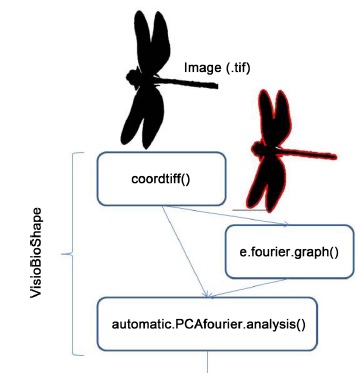VisioBioShapeR: identifying biological images with sound physics

Characterizing weather radar images, identifying mollusk shells deformities due to pollutants or classifying an insect collection according to their wing shape are some of the applications of VisioBioShaper, an innovative program of biological image processing to enable the automatic description of shapes and contours, designed by the experts Biel Stela and Antonio Monleón-Getino, from the Statistics Section from the Department of Genetics, Microbiology and Statistics of the University of Barcelona.

Characterizing weather radar images, identifying mollusk shells deformities due to pollutants or classifying an insect collection according to their wing shape are some of the applications of VisioBioShaper, an innovative program of biological image processing to enable the automatic description of shapes and contours, designed by the experts Biel Stela and Antonio Monleón-Getino, from the Statistics Section from the Department of Genetics, Microbiology and Statistics of the University of Barcelona.
An article published in the scientific journal Open Access Library Journal (OALib) describes the properties of the new program VisioBioShaper, based on the physics of sound waves and applicable to any study field requiring characterization of image processing (ecology, zoology, meteorology, etc.).
Identifying images with the language of R programming
In general, scientific teams use a wide range of programs during the researching activity but they donʼt use the ones focused on biological image processing. Nowadays there are programs of great interest used for several reasons -from acquiring images to treating data to get results- but they require specific knowledge and, in addition, they are usually exclusive and have a high cost.
“The objective of the VisioBioShape pack for R is to add functions to the language of R programming, which is a free programming environment for computing and statistic graphics used by the scientific and technical community worldwide” says Professor Antonio Monleón-Getino, member of the Research Group on Biostatistics and Bioinformatics (GRBIO), team member of the platform Bioinformatics Barcelona (BIB).
“R is gathered and carried out in a wide range of Unix, Windows and MacOS platforms” continues Monleón-Getino. "Therefore, researchers who use this R language for data treatment donʼt have to get into another language or program which can be more complex regarding these kinds of image analyses”.
VisioBioShapeR: describing contour with harmonics
The technique used by the experts is based on the field of sound treatment, a field in which acoustic waves are described with a series of simple harmonics. “It happens the same with contour: the description of a “wave” that adapts to the contour and the harmonics of this wave are used as descriptors. With the obtained descriptors, we can carry out several analyses on the variation of contour. Using the program VisioBioSpaher, computers identify the contours listening to the shapes” says Biel Stela, expert in programming and automatic identification of images, and first author of the article.
The concept of listening to these shapes comes from representing information of images with harmonics and their coefficient. With this, the computer can work on a numerical representation of the contour, where each harmonic is a trait. According to the authors, this methodology enables the classification with automatic learning algorithms.
VisioBioShapeR is based on the Fourier descriptor method (MDF), a technique which is widely used in the field of telecommunications and computing science. This technology, first applied in the eighties, for contour description, was firstly used to identify handwritten characters. Now its field of usage has spread to different fields of machine vision.
This new program allows its use during the researching process by the users that know the language of R programming. In addition, the tools of image analysis are integrated in the work in a very accessible and easy way.
Most formats are readable by R, a characteristic that enables the application of VisioBioShaper. This system requires the content of the image to be binary, that is, it has to have two pixel value (one for background and another for the object description). To go from a colored image to a binary image, it is necessary to use a threshold value. According to the image characteristics, this can be a complex process which requires a specialized program for the image treatment. According to the authors, “VisioBioShapeR can be used to study any organism or object that can be characterized by its environment”.
The authors are currently collaborating with the group GAMA (Group on Meteorological Hazard Analysis) of the University of Barcelona and Servei Meteorològic de Catalunya to create a model able to identify shapes of weather radars in real time, to improve the knowledge of the life cycle of storms.
Article reference:
Biel Stela and Antonio Monleón-Getino. «Facilitating the automatic characterisation, classification and description of biological images with the VisionBioShape package for R». Open Access Library Journal, October 2016. Doi: 10.4236/oalib.1103108
